Early in the morning you will visit the Highlands of Santa Cruz, where you will see Galapagos Giant Tortoises in its natural habitat at El Chato Reserve. After this visit, you will be transferred to Baltra Airport and take your flight back to the continent.
San Cristobal Airport: Departure from Quito or Guayaquil to San Cristobal (2 1/2 hours flight). Arriving in Galapagos, passengers are picked up at the airport by our naturalist guides and taken to the pier to board the M/Y Coral I or M/Y Coral II.
Interpretation Center & Frigatebird Hill : The interpretation center is full of interesting information and offers the perfect overview to the formation of Galapagos, its significance in the world, threats and conservation efforts. Followed by a hike to Frigatebird Hill (Cerro Tijeretas) we will have great looks at both species of frigatebird, with the bonus of a beautiful view of the bay below.
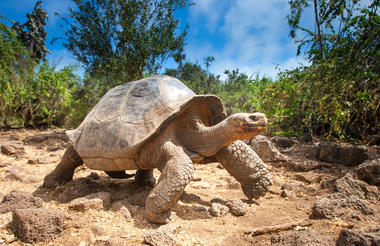

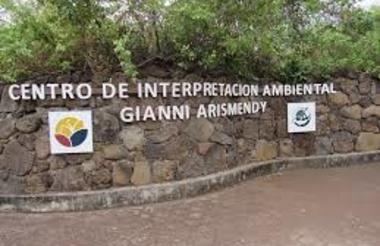
Breakfast
Lunch
Dinner
Kicker Rock & Cerro Brujo (San Cristobal Island) & Punta Pit (San Cristobal Island) Sea lions will greet us as we land on the beach and prepare for our climb to a high point on the steep eroded tuff cone. This is the only place in the islands where we will enjoy the chance to see all three of the booby species in the same place. The red-foots will be perched on the Cordia lutea and small trees, the Nazcaís on the ground near the cliff edge while the blue-foots will be a little further inland. Frigatebirds will be all around and the views are breathtaking.

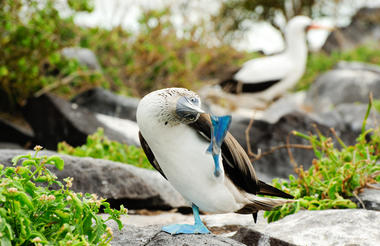
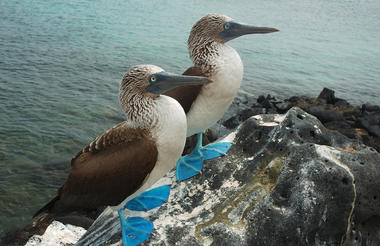
Punta Suarez (Espanola Island) One of the highlight visits of the trip. Punta Suarez seems to have everything - a naturalistís paradise. A slew of marine iguanas and sea lions greet us at the landing site from where our walk continues with close encounters of boobies, endemic lizards, gulls and even a dramatic blow hole. The oldest extant island in the archipelago it is our only opportunity to commune with the endemic waved albatross during their breeding season between April and December. With luck, we can watch their complex courtship display.
Gardner Bay (Española Istand): One of the most stunning beaches in all of Galapagos. The long, white, sandy beach, lapped by turquoise waters is home to a colony of Galapagos sea lions, indifferent to the humans that walk amongst them. The Hood mockingbirds, endemic to this particular island, will be eager to inspect the visitors and satisfy their innate curiosity. Darwinís finches may also join the throng including the reclusive warbler finch. We can also snorkel here from the beach, in the shallows of the bay
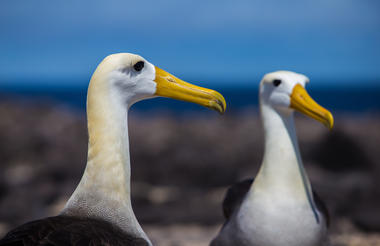
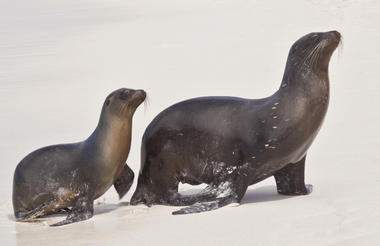

Punta Cormorant / Champion (Floreana Island) : Wet landing, on an olivine green, sanded beach. We hike from the black mangrove beds to a brackish lagoon, which usually holds one of the largest flamingo populations in the Galapagos. This island features some endemic plants such as Scalesia villosa, white and black mangrove, and holy stick. The trail continues to a beautiful white sandy beach, one of the most important nesting sites of Green Pacific Sea Turtles. It is important to avoid walking in the water due to the Sting Rays that may be hiding in the sand, which can be dangerous if accidentally stepped on. From the beach, one can spot sea turtles, blue-footed boobies plunging into the water, and small reef sharks floating along the shoreline in the search for food. This coral-sand beach marks the end of our trail, and we head back to the olivine beach we landed on, to swim or snorkel amongst sea turtles, reef fish, sea lions and, on a good day, white-tipped reef sharks. A small colony of penguins resides on Floreana and can sometimes be observed as well.
Post Office Bay: Wet landing. Located on the north side of Floreana, the bay was named because in 1793 Captain James Colnett installed a wooden barrel which served as an informal post office for sailors passing through, who would take letters with them back to their destinations. Today, visitors continue the tradition by placing unstamped postcards inside the barrel, hoping that some other traveler, going to the letter destination, will take it back for free. The chances are that the letter posted can take a long time to arrive at its destination. However, there have been cases where it has arrived before the sender. We may also encounter Darwin’s finches, Yellow Warbler and Lava Lizards. Great snorkeling opportunities with Green Pacific Sea Turtles. As well, the island is best known for its endemic vegetation: Scalesia villosa, Lecocarpus Pinnatifidus, and the Galapagos Milkwort. Snorkelers can practice on the main beach among playful sea lions.



Cormorant Point
Breakfast
Lunch
Dinner
Highlands Tortoise Reserve (Santa Cruz Island) : Dry landing. In the mountains of Galapagos is possible to admire different kind of birds, such as: tree and ground finches, vermillion flycatchers, paint-billed crakes, yellow warblers, and cattle egrets (usually standing on the tortoises’ shell). The journey to the reserve offers great opportunities to see the contrasts that the island offers in reference to the variety of ecosystems. The road goes from the coast through the agricultural zone and straight up to the dense humid forests. Often, Galapagos Giant Tortoises are also seen on the way, wandering through pastures in the paddocks. This spot is a birdwatchers’ haven, since almost every land bird present on the island lives or migrates here.
After the visit, passengers will be transferred to the airport for their return flight to Guayaquil or Quito.
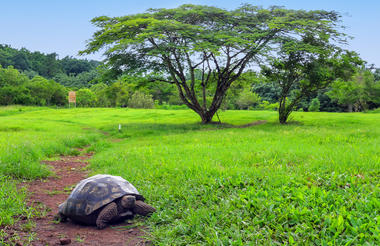
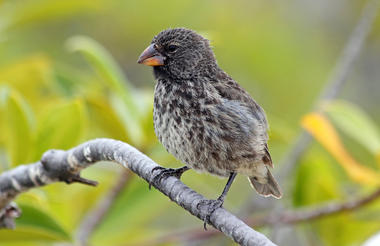
Breakfast







